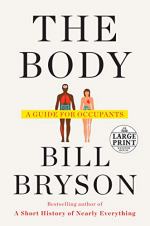|
This section contains 513 words (approx. 2 pages at 400 words per page) |

|
The Body Summary & Study Guide Description
The Body Summary & Study Guide includes comprehensive information and analysis to help you understand the book. This study guide contains the following sections:
This detailed literature summary also contains Topics for Discussion on The Body by Bill Bryson.
The following version of this book was used to create this guide: Bryson, Bill. The Body: A Guide for Occupants. Doubleday, 2019.
The Body: A Guide for Occupants is best-selling author Bill Bryson’s comprehensive tour of the body and its processes. The book contains 23 chapters focused largely on parts of the body, including “The Brain,” Chapter 4, “The Head,” Chapter 5 and the “Immune System,” Chapter 12. The book also contains a number of chapters that deal with the body’s processes and occurrences, including Chapter 10, “Bipedalism and Exercise,” and Chapter 20, “When things Go Wrong: Diseases.” The book serves as a sweeping tour of everything an ordinary person might want to know about his or her body. It includes recent scientific studies on everything from the human microbiome to the G-spot and uses a great deal of humor to impart wisdom. Bryson attempts to instill wonder in readers about their bodies while also dispelling common myths. In the end, he creates an image of the body as a mysterious, marvelous universe that might never be fully understood by medical science. He argues that modern lifestyles are harming human health and that we should all pay more attention to our bodies.
The book addresses a number of themes connected to medicine and human understanding of our bodies including how much medical science still does not know about our bodies. Bryson points out that although medical science has made incredible breakthroughs, we still have much to learn about many parts of our bodies including: the brain, the immune system, our microbiome and even why we sleep or cry emotional tears. The book deals with many episodes from medical science’s past, including a cast of eccentric scientist characters, many of whom made incredible advancements without adhering to ethics. Additionally, Bryson reveals that, in its past, medicine often confirmed dominant societal biases including sexism and racism. Medical treatment for women has long been unequal, Bryson notes, and rates of mother and infant mortality in the United States are still somewhat alarming. The book also includes a discussion of how some sought to use medical science to prove racist ideas that white male Europeans were superior to other races.
Several chapters use graphic detail to impart the cruelty of medicine in the past, including descriptions of painful breast cancer surgeries and lobotomies. Bryson notes medical advancements made at the cost of the lives of war prisoners during WWII when the Japanese and the Germans experimented widely and cruelly on them. The latter parts of the book deal with the cost of medical treatment, exorbitantly high in the United States, and why this does not lead to better care for patients. Bryson calls out the pharmaceutical drug industry for its role in the opioid crises and other breeches of ethics and tells the story of how cigarette manufacturers managed to discredit scientific information about the link between smoking and lung cancer for decades. In all, he shows how far medicine and understanding of the human body has come, while also pointing out we have a long way to go.
Read more from the Study Guide
|
This section contains 513 words (approx. 2 pages at 400 words per page) |

|



